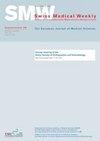输血的血红蛋白阈值:我们在 "明智选择 "时代做得如何?回顾性队列研究
IF 2.1
4区 医学
Q2 MEDICINE, GENERAL & INTERNAL
引用次数: 0
摘要
导言:临床实践指南和 2012 年发起的 "明智选择 "倡议建议,对病情稳定的住院患者输注红细胞的血红蛋白(Hb)阈值为 70-80 克/升。有关内科住院患者输血实践及其趋势的数据十分有限。为了填补这一空白,我们对普通内科和其他诊所的输血实践及其趋势进行了调查。方法:这项回顾性队列研究分析了瑞士一所大学医院 2012 年至 2019 年期间所有输注红细胞的住院患者的数据。如果可以获得输血前血红蛋白,我们将所有首次输血病例都纳入研究范围。主要终点是输血前平均血红蛋白;次要终点包括潜在输血不足(即血红蛋白≥80 g/l时的输血)和接受单个RBC单位。使用广义估计方程估计输血前平均血红蛋白随时间变化的趋势,并使用多变量调整广义估计方程模型确定潜在输血不足的风险因素。结果:在14598例输注红细胞的住院病人中,有1980人(13.6%)从普通内科出院。从2012年到2019年,普通内科的平均输血前血红蛋白从74.0克/升降至68.8克/升(平均年降幅为-0.76克/升,95%置信区间[CI] -0.51至-1.02),其他门诊的平均输血前血红蛋白从78.2克/升降至72.7克/升(平均年降幅为-0.69,95%置信区间[CI] -0.62至-0.77;交互作用P为0.53)。在研究期间,普通内科的潜在输血不足总比例为 17.8%,其他诊所为 24.1%(P <0.001),普通内科从 26.9% 降至 5.5%,其他诊所从 37.0% 降至 15.2%。相比之下,接受单个 RBC 单位的病例比例有所上升(普通内科从 39.5% 上升至 81.4%,其他诊所从 42.7% 上升至 66.1%)。年龄较大(≥65 岁与 <65 岁的调整赔率比 [aOR] 为 1.45,95% CI 为 1.32-1.58)、做过手术(aOR 为 1.24,95% CI 为 1.14-1.36)、急性大出血(aOR 为 1.16,95% CI 为 1.02-1.33)、慢性心力衰竭(aOR 为 1.17,95% CI 为 1.04-1.32)、缺血性心脏病(aOR 为 1.27,95% CI 1.15-1.41)、慢性肺部疾病(aOR 1.24,95% CI 1.08-1.42)、恶性肿瘤(aOR 1.11,95% CI 1.01-1.21)和风湿性疾病(aOR 1.27,95% CI 1.01-1.59)是潜在输血不足的危险因素。结论:随着时间的推移,普通内科和其他诊所采取了更严格的输血措施,这表明指南建议和 "明智选择 "倡议得到了越来越多的遵循。减少潜在输血不足的干预措施应针对老年患者、手术患者或慢性心肺疾病患者。本文章由计算机程序翻译,如有差异,请以英文原文为准。
Haemoglobin thresholds for transfusion: how are we doing in the era of Choosing Wisely? A retrospective cohort study
INTRODUCTION: Clinical practice guidelines and the Choosing Wisely initiative launched in 2012 recommend a haemoglobin (Hb) threshold of 70–80 g/lfor red blood cell (RBC) transfusions in stable hospitalised patients. Data on transfusion practices and their trends in medical inpatients are limited. To address this gap, we investigated transfusion practices and their trends in general internal medicine and other clinics. METHODS: This retrospective cohort study analysed data from all hospitalisations with RBC transfusions at a Swiss university hospital between 2012 and 2019. We included all first transfusion episodes if pretransfusion Hb was available. The primary endpoint was mean pretransfusion Hb; secondary endpoints included potentially inadequate transfusions (i.e., transfusions at Hb ≥80 g/l) and receipt of a single RBC unit. Trends in mean pretransfusion Hb over time were estimated using generalised estimating equations, and risk factors for potentially inadequate transfusions were identified using multivariable adjusted generalised estimating equations models. RESULTS: Of 14,598 hospitalisations with RBC transfusions, 1980 (13.6%) were discharged from general internal medicine. From 2012 to 2019, mean pretransfusion Hb decreased from 74.0 g/l to 68.8 g/l in general internal medicine (mean annual decrease –0.76 g/l, 95% confidence interval [CI] –0.51 to –1.02) and from 78.2 g/l to 72.7 g/l in other clinics (mean annual decrease –0.69, 95% CI –0.62 to –0.77; p for interaction 0.53). The overall proportion of potentially inadequate transfusions was 17.8% in general internal medicine and 24.1% in other clinics (p <0.001) and decreased over the study period from 26.9% to 5.5% in general internal medicine and from 37.0% to 15.2% in other clinics. In contrast, the proportion of cases receiving a single RBC unit increased (39.5% to 81.4% in general internal medicine, 42.7% to 66.1% in other clinics). Older age (adjusted odds ratio [aOR] 1.45, 95% CI 1.32–1.58 for ≥65 vs <65 years), having surgery (aOR 1.24, 95% CI 1.14–1.36), acute haemorrhage (aOR 1.16, 95% CI 1.02–1.33), chronic heart failure (aOR 1.17, 95% CI 1.04–1.32), ischaemic heart diseases (aOR 1.27, 95% CI 1.15–1.41), chronic pulmonary diseases (aOR 1.24, 95% CI 1.08–1.42), malignancy (aOR 1.11, 95% CI 1.01–1.21), and rheumatic disease (aOR 1.27, 95% CI 1.01–1.59) were risk factors for potentially inadequate transfusions. CONCLUSIONS: More restrictive transfusion practices were adopted in general internal medicine and other clinics over time, suggesting that guideline recommendations and the Choosing Wisely initiative may have been increasingly followed. Interventions to reduce potentially inadequate transfusions should target providers who care for older patients and those with surgery or chronic cardiac and pulmonary diseases.
求助全文
通过发布文献求助,成功后即可免费获取论文全文。
去求助
来源期刊

Swiss medical weekly
医学-医学:内科
CiteScore
5.00
自引率
0.00%
发文量
0
审稿时长
3-8 weeks
期刊介绍:
The Swiss Medical Weekly accepts for consideration original and review articles from all fields of medicine. The quality of SMW publications is guaranteed by a consistent policy of rigorous single-blind peer review. All editorial decisions are made by research-active academics.
 求助内容:
求助内容: 应助结果提醒方式:
应助结果提醒方式:


